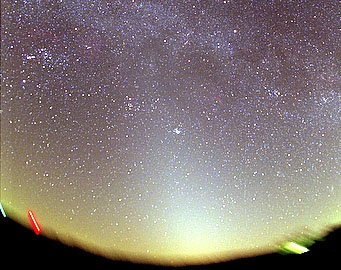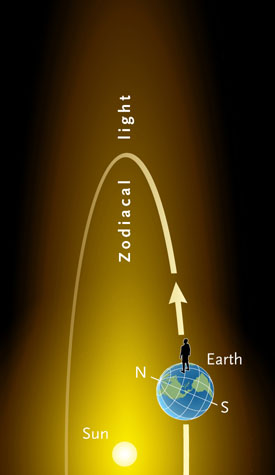The first time I knowingly saw the zodiacal light, it was so bright that I couldn't believe I'd never seen it before. I was in Chile, across the valley from the professional observatories at Cerro Pachon and Cerro Tololo. I commented to my host, the superb astrophotographer Daniel Verschatse, that the light pollution from nearby La Serena was unbelievably intense. The light in the west was washing out even the Sagittarius Milky Way, which was quite high in the sky at the time.

The pyramid of pearly light reaching from the horizon through the Pleiades (just right of center) is the zodiacal light.
Doug Zubenel
"Look again," said Verschatse. "That's not light pollution; it's the zodiacal light! See its tall, triangular shape? See how it leans to the right, following the ecliptic?" (In the north, the evening zodiacal light leans left, as shown at right.)
Now that I know what to look for, I see the zodiacal light quite often. I've even seen it — just barely — from my astronomy club's observing field in the outer Boston suburbs. But it's much more prominent if you're far from any artificial light pollution. It's well worth the trip.
The zodiacal light is brightest and broadest near the Sun. But the very brightest part of all can never be seen from Earth, because it's overwhelmed by the Sun's glare. So your best opportunities come right before the onset of morning twilight and after the end of evening twilight, when you can see the sky quite close to the Sun, but the Sun's light is blocked by our own planet.

S&T: Casey Reed
And since the zodiacal light follows the ecliptic, it's easiest to see when the ecliptic runs highest in the sky near twilight, as shown at right. In the Northern Hemisphere, that happens during the evening from late January through early April, and in the morning from Septmeber through November. (The situation is reversed in the Southern Hemisphere, which is why I could see the zodiacal light so easily on an October evening in Chile.)
Most people prefer to view in the evening, so late winter and early spring are the ideal time. Find spot as far as possible from any artificial lights that has a low western horizon. Go there shortly after sunset on a moonless evening and watch for the zodiacal light to appear as twilight fades.
What are you seeing? The zodiacal light is the combined glow of countless tiny particles (debris from comets and asteroid collisions) that orbit the Sun. Like the dust in an unswept room, their mass is minuscule but their combined surface area is quite large, so they reflect a lot of sunlight. In fact, if it could be condensed into a single point, the zodiacal light would handily outshine all the planets, including even Venus.
As an interesting side note, Brian May, founding member of the rock group Queen, completed his doctoral dissertation on the zodiacal light in 2007, obtaining a PhD in astrophysics from Imperial College in London. He had started the thesis in 1970, but took a 35-year break to become a rock celebrity.
Have you seen the zodiacal light? Then share your impressions below with the rest of our readers.
 12
12









Comments
Hoshizora
March 31, 2008 at 12:35 pm
That's so cool! I wish I can see it!
You must be logged in to post a comment.
Roberto
April 4, 2008 at 10:03 am
I was astonished at how bright the Zodiacal Light was when I was observing in the fall pre-dawn skies at the Grand Canyon. At first I thought I was seeing the Milky Way, it was so bright. But the light followed the ecliptic, and Jupiter was rising right in the middle of it. Even a casual observer could easily see it. However, to see the Zodiacal Light that well, one must have perfectly clear skies, and be far away from all light pollution.
You must be logged in to post a comment.
Bob Davis
April 4, 2008 at 2:54 pm
I had read about the zodiacal light, but didn't take much note of its existence, when I first saw it, which was in more complete splendor than any of my sightings since then. I was walking from my home to Drake Observatory in Des Moines, Iowa--probably the summer of 1945--to the weekly (in summer) lecture by one of the Drake University professors. At that time the professor was from the mathematics department, and he was happy to have high school students operate the telescope after the lecture for the visitors (and for an hour or so after the last visitor left). In any case, it was a sparkling clear evening and the zodiacal light was not only highly obvious, but was the most spectacular sight in the evening sky--narrowing down in the vicinity of the gegenschein, but still obvious where it connected to the gegenschein, which was also spectacularly bright. It wasn't until quite a bit later that I realised that what I had seen was the zodiacal light and the gegenschein. I have seen both many times since then--usually on observing trips to various Arizona mountain-top observatories.
You must be logged in to post a comment.
David Harrington
April 5, 2008 at 9:13 am
After perhaps forty years of active skywatching, wondering if I would ever see the fabled Zodiacal Light, there it finally was--unmistakably--in the same clear
evening sky with wonderful comet Hale-Bopp! Said April sky was that of Big Island, and I was standing by the far edge of the Mt. Kilauea crater, where I'd come for a good view of the comet. Hawaii's Big Island draws thousands of astronomy buffs due to the great observing conditions; but that particular night must have been one of the best, as the naked-eye comet was displaying two clear, colored tails, something I had never before been lucky enough to see. And what was that strange, huge afterglow over there on the left that drew the eye from the graceful comet? Bingo! The long-wondered-about Gegenschein at last! It simply dominated the western sky, perhaps a quarter of the way to the zenith, with a golden, rather parabolic shape. And yes, it leaned to the left! What a sky there must be for those pros up on Mauna Kea almost every night!
You must be logged in to post a comment.
Jon Zander
April 8, 2008 at 5:08 pm
In March of 2005 I went to Lunar Crater in central Nevada to try my first Messier Marathon. I noticed how Las Vegas and Tonopah were casting very strong light domes. It wasn't until later while looking at maps that I realized the light was not in the proper positions for those cities. I realized this nuisance was actually the Zodiacal Light!
The last time I saw it I was able to share it with my family from Death Valley, early in 2008.
You must be logged in to post a comment.
John Bortle
April 10, 2008 at 11:50 am
Most unfortunately, the great majority of today's amateur astronomers live in areas whose skies are sufficiently compromised by light pollution as to render the Zodiacal Light all but undetectable. But this was not always so. In the post-war years up through the 1960's, it was possible to see the ZL quite well even from the outer suburbs of many of the larger cities. From the rural areas only a bit more distant, it was a truly wonderful sight.
During the 1970's, from my residence about 75 miles north of NYC, the Zodiacal Light was a striking feature on most any moonless spring evening, or autumn morning. This huge, tapering, cone of light would stretch upwards into the heavens 60-degrees, or more, with its core glowing brightly enough as to extinguish many of the fainter stars within it. One feature I always found particularly striking was the ZL's color - a decidedly "warm" hue that contrasted dramatically with the cold, blue-white light of the milky way whenever the two were situated more-or-less in the same part of the sky.
On many evenings the ZL was not the only strange glowing feature I would note in the heavens. When appropriately situated, I could generally spot an elongated, softly glowing patch of mist well south of zenith around local midnight, which was the Gegenschein. And on the very best nights, more often than not during the pre-dawn hours when even the minimal local lighting had been extinguished, the light-bridge of the Zodiacal Band could be detected with averted vision joining the ZL cone in the eastern sky with the Gegenschein well down in the west.
Sadly, the explosive growth of urban sprawl in recent decades has robbed most of us in the northeastern U.S. (and elsewhere) of any majestic views of the Zodiacal Light, Gegenschein, or the even more elusive Zodiacal Band. Even at my distance from the major metropolitan centers, the skies have become so bright that these celestial features live on for me only in memories
You must be logged in to post a comment.
LS
April 11, 2008 at 9:01 am
What is the Gegenschein?
You must be logged in to post a comment.
Tony Flanders
April 14, 2008 at 7:42 am
L S April asked "What is the Gegenschein?"
The zodiacal light actually stretches all the way across the sky every night, though the part of it near the setting or rising Sun is by far the brightest and easiest to see. There's a secondary brightening exactly opposite the Sun called the Gegenschein (German for "counter shine"). It's moderately faint, very large, very vague, and generally visible only if your skies are pretty close to fully dark.
You must be logged in to post a comment.
Mariala
June 3, 2008 at 12:48 pm
I think I may have seen the zodiacal light before on a vacation to South Padre Island in Texas. Im pretty sure because it was aligned on the ecliptic, I know, and I remember it resembling the picture in Sky and Telescope a little. Wish I could see it again!
You must be logged in to post a comment.
Wayne Archer
March 6, 2010 at 8:38 pm
This is the first time that I have ever heard of the Zodiacal Light. I live 27 miles from Philadelphia and 7 miles from Chester. The light from the cities has stoped me from useing my telescope.It looks to be a real challenge but I will try. Thank you for this.
You must be logged in to post a comment.
William Shackelford
March 7, 2010 at 6:40 pm
One of the reasons I enjoy going to the Okie/Tex Star Party in Oklahoma is the fabulous view I get of the zodiacal light. The site is rated on The Bortle Light Pollution Scale at 1 which is the darkest sky level listed. This star party is in the Fall which makes the zodiacal light appear in the morning sky. It is always fantastic, can be seen so easily, and is actually visible as the zodiacal band right over my head and behind me. The Gegenschein is also very obvious in the middle of the night. There is nothing like staying up all night observing and finishing it all off with the zodiacal light. John Bortle, I enjoyed your comments.
You must be logged in to post a comment.
mike mcclurg
January 26, 2013 at 7:01 pm
I'm trying to get my bearings straight. Does the left or right tilt really change due to which hemisphere you are in, or is it more what season and whether it's morning or evening?
Just asking.
You must be logged in to post a comment.
You must be logged in to post a comment.